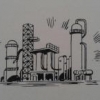Latest Downloads
-
 Water Bath Indirect Heaters
Water Bath Indirect HeatersArt Montemayor - Oct 12 2018 02:35 PM
-
 Petroleum: A Primer for Kansas
Petroleum: A Primer for KansasArt Montemayor - Oct 12 2018 02:27 PM
-
 Spray Tower for Flue Gas Scrubbing Design
Spray Tower for Flue Gas Scrubbing Designankur2061 - May 02 2018 02:31 PM
-
 Selection of Vertical Tanks
Selection of Vertical Tanksankur2061 - Apr 19 2018 07:42 AM
-
 Pressure Drop Calculator for Strainers 1
Pressure Drop Calculator for Strainers 1ankur2061 - Mar 24 2017 02:04 PM
-
 Horizontal Pig Trap System Design Guidelines
Horizontal Pig Trap System Design Guidelinesankur2061 - Jan 14 2017 02:54 PM
-
 Performance Prediction of 3-Stage Propane Refrigeration System
Performance Prediction of 3-Stage Propane Refrigeration Systemankur2061 - Aug 08 2016 02:43 PM
-
 Centrifugal Pump Troubleshooting Checklist
Centrifugal Pump Troubleshooting Checklistankur2061 - Dec 17 2015 08:18 AM
-
 Compressor Troubleshooting Checklist
Compressor Troubleshooting Checklistankur2061 - Sep 08 2015 11:43 AM
-
 Amine Sweetening Unit Preliminary Design
Amine Sweetening Unit Preliminary Designankur2061 - May 19 2015 09:35 AM
Popular Store Titles
 Tank Jacket Calculator
Tank Jacket Calculator
 Specification Sheet Collection
Specification Sheet Collection
 PIPESIZE
PIPESIZE
 Relief Valve Sizing
Relief Valve Sizing
 Rupture Disc Sizing
Rupture Disc Sizing
Chemical and Process Engineering Resources
Submitted Chris Haslego, Nov 21 2011 11:21 AM | Last updated Nov 21 2011 01:29 PM
| Category: | Refining |
| Question: | What is a good method of cleaning a crude tower? |
| Keywords: | v1i8,crude,tower,distillation,column,cleaning,procedure |
| Answer: | Here is a typical progression:1. Steaming: The steaming is done after all liquid hydrocarbons have been drained from the column and associated piping. The objective of steaming is to make the column and associated piping free of residual hydrocarbons. The column vent and pump strainers in the side draw piping are de-blinded and steaming is started from utility connections at the bottom of the column. Generally, steaming is continued for about 20 to 24 hrs, ensuring the column top temperature remains more than 100 ??C throughout the operation.2. Hot Water Washing: When clear steam is observed exiting the column vents, water washing of the column should be started. With steam still in commission, water is sent to the column, usually via reflux lines, and it is drained from the column bottom, associated pump strainers, etc. The water flow rate should be adjusted so that steam still comes from the vent (i.e. water should not result in condensing of all steam before it reaches the column top). Water flow should be stopped for 2-3 hrs and then resumed. This cycle of steaming and washing should be repeated several times for a total of about 15 to 20 hours. Injection of a turpene-based detergent into the steam can also be considered. The condensate-soap solution can be collected and circulated through the various side cuts. 3. Blinding: When clear water is observed at side draw pump strainers, etc., associated piping should be isolated by installing blinds wherever isolation is possible.4. Cold Water Washing: The hot water wash should be followed by a cold water wash (i.e. steam should be fully closed). The cold water washing is done for about 20-24 hrs. 5. Chemical Injection for Removal and Neutralization of PIS Deposits: During the cold-water wash or after washing is over, chemical injection for removal of pyrophoric sulfides should be considered. The various options for chemical treatment are discussed below: Acid cleaning - This procedure involves pumping in an acid with some corrosion inhibitor. The acid dissolves sulfide scale and releases hydrogen sulfide gas. It is effective and inexpensive, however, disposal of hydrogen sulfide gas can be a problem, as can corrosion (when the system contains more than one alloy). Dilute hydrochloric acid solutions may also be used. The resulting iron chloride turns bright yellow, acting as an indicator for removal of the iron sulfide. Acid plus hydrogen sulfide suppressant - Additional chemicals can be added to the acid solution to convert or scrub the hydrogen sulfide gas. Chelating solutions - Specially formulated, high pH, chelating solutions are quite effective in dissolving the sulfide deposits without emitting hydrogen sulfide, but this is an expensive application. Oxidizing chemicals - Oxidizing chemicals convert sulfide to oxide. Potassium permanganate (KMnO4) has been used commonly in the past to oxidize pyrophoric sulfide. Generally the potassium permanganate is added to the tower during the cold water washing as a 1% solution. At various intervals, samples are taken and checked for color. The colors of the fresh KMnO4 and the spent MnO2 are purple and brown respectively. If the color of the solution becomes brown, additional KMnO4 is needed. The reaction is judged complete when the solution color remains purple. It takes approximately 12 hours to complete the job. In recent times, the use of potassium permanganate as an oxidizer has raised serious safety and health concerns. A very good alternative to explore is the use of a cleaning agent called Zyme-Flow from United Laboratories (see link below).Reference: Pryophoric Iron Fires, www.cheresources.com/ironfires.shtml |
| Links: | Zyme-Flow Website Pryophoric Iron Fires Article |
| Images: |
Forum Quick Links
Tech Q & A Category List
-
 Bulk Solids
Bulk Solids
-
 ChE Outside the Plant
ChE Outside the Plant
-
 Chemical Process Business
Chemical Process Business
-
 Chemistry Basics
Chemistry Basics
-
 Corrosion
Corrosion
-
 Equipment Design
Equipment Design
-
 Experimentation and Testing
Experimentation and Testing
-
 Fluid Dynamics
Fluid Dynamics
-
 Heat Transfer Technology
Heat Transfer Technology
-
 Industrial Utilities
Industrial Utilities
-
 Mass Transfer
Mass Transfer
-
 Physical Property Information
Physical Property Information
-
 Plant Basics
Plant Basics
-
 Plant Economics
Plant Economics
-
 Preparing to Become an Engineer
Preparing to Become an Engineer
-
 Process Control
Process Control
-
 Reactions and Processes
Reactions and Processes
-
 Refining
Refining
-
 Safety
Safety
-
 Separation Technology
Separation Technology
-
 The Environment
The Environment
-
 Thermodynamics
Thermodynamics

 FB
FB



0 Comments